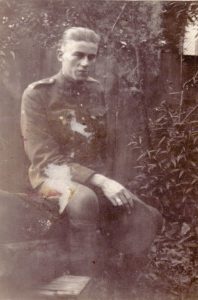At three-quarters of an inch taller than 6 feet and weighing in at only 150 pounds was it any surprise his friends called him Slim. He was single, trained as a painter, still lived at home with his parents, and at just 4 months beyond his 18th birthday he enlisted with the Army. That date was April 10, 1916.
We don’t know what finally moved him to walk into the enlistment office. Perhaps it was the relentless recruiting effort of members of the 91st Battalion of Elgin County. Perhaps it was the propaganda that questioned the masculinity, patriotism and love of their mother for all young men who had not yet enlisted. Perhaps it was the propaganda of life under German rule that was splashed across every newspaper in Canada. Most likely it was because his cousin Merrill had enlisted just the day before.
Due to recruiting efforts lasting up to the day they left, the training provided the recruits of the 91st Battalion was substandard and did little to ready the men for actual fighting. Having no prior military service and only cadet training Slim was among those ill prepared for war.
Nevertheless, they left the barracks on June 25, 1916, 923 men and 33 officers led by a brass band for the march to the main street of our small town and the two waiting trains festooned with banners declaring “St. Thomas to Berlin”. From there they travelled to Halifax where the men boarded the HMS Olympic, a sister ship to the Titanic, heading for Liverpool England.
After the required period of quarantine the men of the 91st were split up to provide reinforcements for 23 other units at the front. It was common practice to divide county battalions among several units to avoid the annihilation of the entire population of young men in battle. Members of the 91st participated in battles at the Somme, Arras, Passchendaele, Ypres, St.Eloi, Vimy Ridge and Amiens. Fifty-five officers and 167 ranked personnel were killed or died in service, 1 in 6 members of the 91st that set out in 1916. Fifty percent were wounded, many several times.
 Which brings us back to Slim. After a brief stint with the England’s 6th Reserve, he joined France’s 38th Battalion on August 8, 1916. Early the following year, as part of the Canadian Corps, he joined the British 3rd Army as they surged forward in the wake of a rolling barrage of 2800 guns to seize the German defenses of Vimy Ridge. In that battle Canadians proved themselves as worthy adversaries and tactical planners, taking a strategic position that the French had been unable to do and securing what had been a German stronghold, often in hand to hand combat. As stated in Andrew Wiest’s book An Illustrated History of WWI, “a combination of surprise and artillery effectiveness made it one of the most successful attacks to date in WWI.”
Which brings us back to Slim. After a brief stint with the England’s 6th Reserve, he joined France’s 38th Battalion on August 8, 1916. Early the following year, as part of the Canadian Corps, he joined the British 3rd Army as they surged forward in the wake of a rolling barrage of 2800 guns to seize the German defenses of Vimy Ridge. In that battle Canadians proved themselves as worthy adversaries and tactical planners, taking a strategic position that the French had been unable to do and securing what had been a German stronghold, often in hand to hand combat. As stated in Andrew Wiest’s book An Illustrated History of WWI, “a combination of surprise and artillery effectiveness made it one of the most successful attacks to date in WWI.”
Wounded in that battle, Slim spent the next few weeks recovering back in England. On May 7, 1917 the St Thomas Daily Times printed a letter received by his mother. In it he reassures her that he is “still kicking and getting along fine” and that he is “quite anxious about the boys as I know they were in the scrap on the ridge.”
In all the history books I have ever read I have yet to see the Battle of Vimy Ridge referred to as a “scrap”. It speaks volumes as to the resilience and courage of all the young men who fought in the Great War. It speaks volumes about my grandfather. I will have the opportunity to visit Vimy and the Memorial erected there to honour the Canadians who died. I will be able to stand where my grandfather stood, bravely facing adversity over 100 years ago.
That is at the core of why we travel, the opportunity to see the world not only as it is today, but to appreciate the conflict and courage that brought it to this point.
In most loving memory of Cpl. Charles Edward Baldwin (1897-1982)
